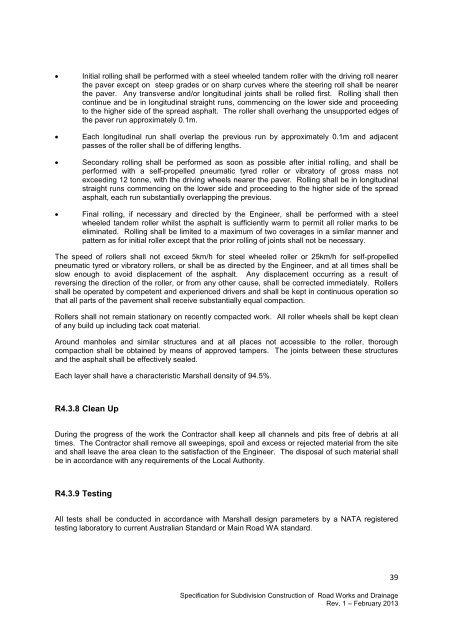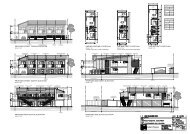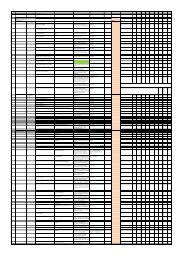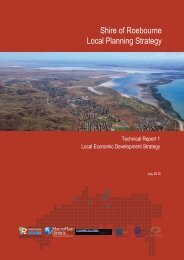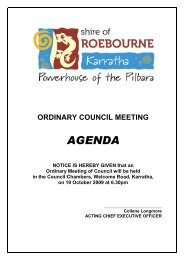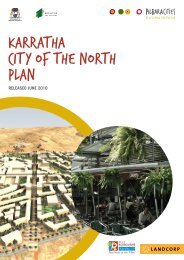specification for subdivision construction of road works and drainage
specification for subdivision construction of road works and drainage
specification for subdivision construction of road works and drainage
Create successful ePaper yourself
Turn your PDF publications into a flip-book with our unique Google optimized e-Paper software.
• Initial rolling shall be per<strong>for</strong>med with a steel wheeled t<strong>and</strong>em roller with the driving roll nearer<br />
the paver except on steep grades or on sharp curves where the steering roll shall be nearer<br />
the paver. Any transverse <strong>and</strong>/or longitudinal joints shall be rolled first. Rolling shall then<br />
continue <strong>and</strong> be in longitudinal straight runs, commencing on the lower side <strong>and</strong> proceeding<br />
to the higher side <strong>of</strong> the spread asphalt. The roller shall overhang the unsupported edges <strong>of</strong><br />
the paver run approximately 0.1m.<br />
• Each longitudinal run shall overlap the previous run by approximately 0.1m <strong>and</strong> adjacent<br />
passes <strong>of</strong> the roller shall be <strong>of</strong> differing lengths.<br />
• Secondary rolling shall be per<strong>for</strong>med as soon as possible after initial rolling, <strong>and</strong> shall be<br />
per<strong>for</strong>med with a self-propelled pneumatic tyred roller or vibratory <strong>of</strong> gross mass not<br />
exceeding 12 tonne, with the driving wheels nearer the paver. Rolling shall be in longitudinal<br />
straight runs commencing on the lower side <strong>and</strong> proceeding to the higher side <strong>of</strong> the spread<br />
asphalt, each run substantially overlapping the previous.<br />
• Final rolling, if necessary <strong>and</strong> directed by the Engineer, shall be per<strong>for</strong>med with a steel<br />
wheeled t<strong>and</strong>em roller whilst the asphalt is sufficiently warm to permit all roller marks to be<br />
eliminated. Rolling shall be limited to a maximum <strong>of</strong> two coverages in a similar manner <strong>and</strong><br />
pattern as <strong>for</strong> initial roller except that the prior rolling <strong>of</strong> joints shall not be necessary.<br />
The speed <strong>of</strong> rollers shall not exceed 5km/h <strong>for</strong> steel wheeled roller or 25km/h <strong>for</strong> self-propelled<br />
pneumatic tyred or vibratory rollers, or shall be as directed by the Engineer, <strong>and</strong> at all times shall be<br />
slow enough to avoid displacement <strong>of</strong> the asphalt. Any displacement occurring as a result <strong>of</strong><br />
reversing the direction <strong>of</strong> the roller, or from any other cause, shall be corrected immediately. Rollers<br />
shall be operated by competent <strong>and</strong> experienced drivers <strong>and</strong> shall be kept in continuous operation so<br />
that all parts <strong>of</strong> the pavement shall receive substantially equal compaction.<br />
Rollers shall not remain stationary on recently compacted work. All roller wheels shall be kept clean<br />
<strong>of</strong> any build up including tack coat material.<br />
Around manholes <strong>and</strong> similar structures <strong>and</strong> at all places not accessible to the roller, thorough<br />
compaction shall be obtained by means <strong>of</strong> approved tampers. The joints between these structures<br />
<strong>and</strong> the asphalt shall be effectively sealed.<br />
Each layer shall have a characteristic Marshall density <strong>of</strong> 94.5%.<br />
R4.3.8 Clean Up<br />
During the progress <strong>of</strong> the work the Contractor shall keep all channels <strong>and</strong> pits free <strong>of</strong> debris at all<br />
times. The Contractor shall remove all sweepings, spoil <strong>and</strong> excess or rejected material from the site<br />
<strong>and</strong> shall leave the area clean to the satisfaction <strong>of</strong> the Engineer. The disposal <strong>of</strong> such material shall<br />
be in accordance with any requirements <strong>of</strong> the Local Authority.<br />
R4.3.9 Testing<br />
All tests shall be conducted in accordance with Marshall design parameters by a NATA registered<br />
testing laboratory to current Australian St<strong>and</strong>ard or Main Road WA st<strong>and</strong>ard.<br />
Specification <strong>for</strong> Subdivision Construction <strong>of</strong> Road Works <strong>and</strong> Drainage<br />
Rev. 1 – February 2013<br />
39


